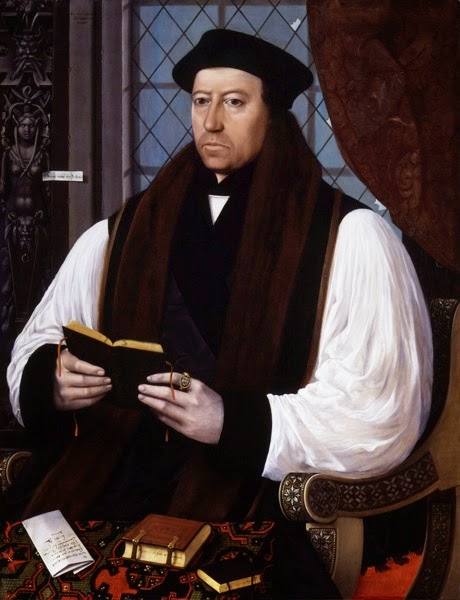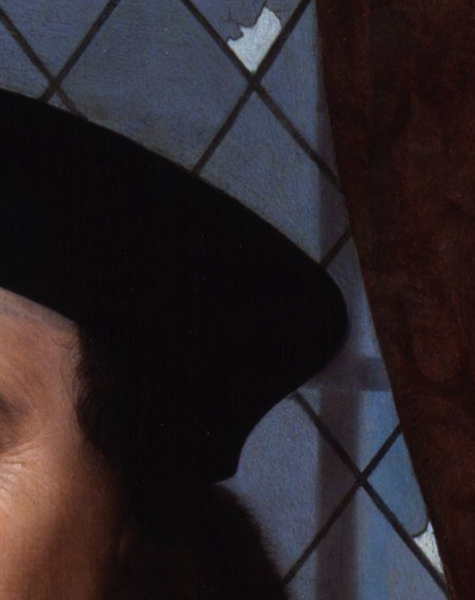

What you see above is the portrait of Thomas Cranmer, Archbishop of Canterbury, painted in 1545 by Gerlach Flicke. It’s now in the National Portrait Gallery in London.
My friend Betsy Childs was recently looking at this picture and noticed something curious: tiny pieces of broken glass, or perhaps chipped glass-coating, in the windows behind Cranmer. Here’s a close-up:

(You can see a high resolution version of the painting here.) Now, this painting is a very detailed one. For instance, Cranmer is holding a copy of the letters of St. Paul and one of the books on the table is Augustine’s On Faith and Works, which together illustrate Cranmer’s commitment to the core Reformation principle of justification by faith. Other elements of the painting have obviously been executed with great care but yield no clear meaning. For instance, what are we to make of the carving on the left — right next to the little strip of paper giving the date of the painting and Cranmer’s age — featuring a naked woman whose private parts are obscured by the face of some strange beast? (The Whore of Babylon, perhaps, against whom Cranmer contended? But why in a carving, and why there?)
But what might the broken or chipped glass mean? Betsy wondered if I knew, and I don’t have even a guess. I checked Diarmaid MacCulloch’s magisterial biography of Cranmer, and while he discusses this painting at some length (pages 338-42), he doesn’t say anything about the glass.
So Betsy wrote to the National Portrait Gallery. One of the curators there responded that the problematic glass was only discovered when the painting underwent restoration in the 1990s, and that it is definitely part of the original composition — but they don’t know what it means either. “Artists and patrons at this time had a very refined symbolic vocabulary, much of which has been lost to modern scholars. The painting is laden with Cranmer’s personal iconography and this device could relate to that. Alternatively, there might be an as-yet undiscovered theological interpretation, or a reference to Cranmer’s own works.”
So: a mystery! Anyone have any guesses?


Hmmm. No idea about the window, but if you've got Ashley Null's book, it looks like he says a bit about the carvings (pp. 96–97), drawing on Anthony Wells-Cole and on the work of Catharine MacLeod (who might even be the NPG curator Betsy corresponded with?). Maybe Wells-Cole takes a stab at the window question.
Upon inspection of the high resolution image, the "glass" looks like the paint it's made of — glass doesn't crack in so many curves, does it? The top chip especially: looks like more "glass" is destined to flake off.
"For now we see through a glass, darkly."
Yes, John McVey, it does look like chipping paint, but the restorationists are convinced that the broken windows are part of the original. Kate Walter of the NPG wrote to me, "The artist painted the sky which appears through the holes with expensive ultramarine pigment, unlike the rest of the sky seen through the glass, for which he used more common azurite."
Thanks Betsy. My wild speculation is that it was painted to look like chipped paint! I wonder also, about the dark thin borders between "glass" and "chip" — what is going on there? Murky skies, for sure!
This sounds more like a question for an art historian…(I would email John Walford)
But let me venture a direction to investigate. The painting was made in 1545-46, just before Edward VI’s Injunctions of 1547 against, among other things, images—including stained glass windows. Another attempt had been made earlier in 1538 by Henry VIII (both largely failed). My guess is that Cranmer had been advocating for this reform for some time, and used young Edward’s ascendency to the throne to his advantage. Perhaps this painting feature is subtle reference to this campaign. My main objection is that I would expect an image to be broken, not merely a window—thus subtlety.
It would be ironic if this bit of (as the National Portrait Gallery has suggested) “personal iconography” related to iconoclasm!
I can't solve the mystery, but the cracked, fragile glass in the first stanza of George Herbert's poem, The Windows, comes to mind…
LORD, how can man preach thy eternall word ?
He is a brittle crazie glasse :
Yet in thy temple thou dost him afford
This glorious and transcendent place,
To be a window, through thy grace.
I think Jake is on the right trail. Reformation and iconoclasm – letting pure light of truth through the (Roman – and pagan – ) stained windows.